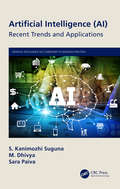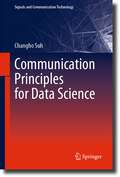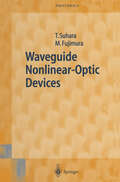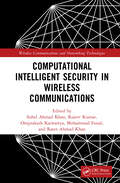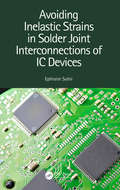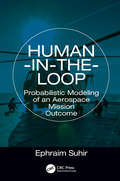- Table View
- List View
Application of Intelligent Systems in Multi-modal Information Analytics: The 4th International Conference on Multi-modal Information Analytics (ICMMIA 2022), Volume 1 (Lecture Notes on Data Engineering and Communications Technologies #136)
by Vijayan Sugumaran A. G. Sreedevi Zheng XuThis book provides comprehensive coverage of the latest advances and trends in information technology, science, and engineering. Specifically, it addresses a number of broad themes, including multimodal informatics, data mining, agent-based and multi-agent systems for health and education informatics, which inspire the development of intelligent information technologies. The contributions cover a wide range of topics such as AI applications and innovations in health and education informatics; data and knowledge management; multimodal application management; and web/social media mining for multimodal informatics. Outlining promising future research directions, the book is a valuable resource for students, researchers, and professionals and a useful reference guide for newcomers to the field. This book is a compilation of the papers presented in the 4th International Conference on Multi-modal Information Analytics, held online, on April 23, 2022.
Application of Intelligent Systems in Multi-modal Information Analytics: The 4th International Conference on Multi-modal Information Analytics (ICMMIA 2022), Volume 2 (Lecture Notes on Data Engineering and Communications Technologies #138)
by Vijayan Sugumaran Zheng Xu A. G. SreedeviThis book provides comprehensive coverage of the latest advances and trends in information technology, science and engineering. Specifically, it addresses a number of broad themes, including multi-modal informatics, data mining, agent-based and multi-agent systems for health and education informatics, which inspire the development of intelligent information technologies. The book covers a wide range of topics such as AI applications and innovations in health and education informatics; data and knowledge management; multi-modal application management; and web/social media mining for multi-modal informatics. Outlining promising future research directions, the book is a valuable resource for students, researchers and professionals and a useful reference guide for newcomers to the field. This book is a compilation of the papers presented in the 4th International Conference on Multi-modal Information Analytics, held online, on April 23, 2022.
Application of Intelligent Systems in Multi-modal Information Analytics: Proceedings of the 2020 International Conference on Multi-model Information Analytics (MMIA2020), Volume 1 (Advances in Intelligent Systems and Computing #1233)
by Vijayan Sugumaran Zheng Xu Huiyu ZhouThis book presents the proceedings of the 2020 International Conference on Intelligent Systems Applications in Multi-modal Information Analytics, held in Changzhou, China, on June 18–19, 2020. It provides comprehensive coverage of the latest advances and trends in information technology, science and engineering. It addresses a number of broad themes, including data mining, multi-modal informatics, agent-based and multi-agent systems for health and education informatics, which inspire the development of intelligent information technologies. The contributions cover a wide range of topics such as AI applications and innovations in health and education informatics; data and knowledge management; multi-modal application management; and web/social media mining for multi-modal informatics. Outlining promising future research directions, the book is a valuable resource for students, researchers and professionals, and a useful reference guide for newcomers to the field.
Application of Intelligent Systems in Multi-modal Information Analytics: Proceedings of the 2020 International Conference on Multi-model Information Analytics (MMIA2020), Volume 2 (Advances in Intelligent Systems and Computing #1234)
by Vijayan Sugumaran Zheng Xu Huiyu ZhouThis book presents the proceedings of the 2020 International Conference on Intelligent Systems Applications in Multi-modal Information Analytics, held in Changzhou, China, on June 18–19, 2020. It provides comprehensive coverage of the latest advances and trends in information technology, science and engineering. It addresses a number of broad themes, including data mining, multi-modal informatics, agent-based and multi-agent systems for health and education informatics, which inspire the development of intelligent information technologies. The contributions cover a wide range of topics such as AI applications and innovations in health and education informatics; data and knowledge management; multi-modal application management; and web/social media mining for multi-modal informatics. Outlining promising future research directions, the book is a valuable resource for students, researchers and professionals, and a useful reference guide for newcomers to the field.
Application of Intelligent Systems in Multi-modal Information Analytics: 2021 International Conference on Multi-modal Information Analytics (MMIA 2021), Volume 2 (Advances in Intelligent Systems and Computing #1385)
by Vijayan Sugumaran Zheng Xu Huiyu ZhouThis book provides comprehensive coverage of the latest advances and trends in information technology, science and engineering. Specifically, it addresses a number of broad themes, including multi-modal informatics, data mining, agent-based and multi-agent systems for health and education informatics, which inspire the development of intelligent information technologies. The contributions cover a wide range of topics such as AI applications and innovations in health and education informatics; data and knowledge management; multi-modal application management; and web/social media mining for multi-modal informatics. Outlining promising future research directions, the book is a valuable resource for students, researchers and professionals, and a useful reference guide for newcomers to the field. This book is a compilation of the papers presented in the 2021 International Conference on Multi-modal Information Analytics, held in Huhehaote, China, on April 23–24, 2021.
Application of Intelligent Systems in Multi-modal Information Analytics: 2021 International Conference on Multi-modal Information Analytics (MMIA 2021), Volume 1 (Advances in Intelligent Systems and Computing #1384)
by Vijayan Sugumaran Zheng Xu Huiyu ZhouThis book provides comprehensive coverage of the latest advances and trends in information technology, science and engineering. Specifically, it addresses a number of broad themes, including multi-modal informatics, data mining, agent-based and multi-agent systems for health and education informatics, which inspire the development of intelligent information technologies. The contributions cover a wide range of topics such as AI applications and innovations in health and education informatics; data and knowledge management; multi-modal application management; and web/social media mining for multi-modal informatics. Outlining promising future research directions, the book is a valuable resource for students, researchers and professionals, and a useful reference guide for newcomers to the field. This book is a compilation of the papers presented in the 2021 International Conference on Multi-modal Information Analytics, held in Huhehaote, China, on April 23–24, 2021.
Practical Approach to 3D Weaving (Materials Horizons: From Nature to Nanomaterials)
by Bangalore Sridharan SugunThree Dimensional Weaving is a nascent technology which has triggered research interests around the world. The technology has the potential to finely balance the in-plane and out-of plane properties in composites. This state-of-the-art book focuses on three emerging 3D weaving technologies viz., Orthogonal weaving, Angle interlock weaving and Dual Plane shedding based 3D weaving. It provides focused knowledge about these technologies and has a pragmatic approach to developing customized 3D weaving machines. Fundamental approach to understanding weave design basics, thereupon practical weaving , addressing quality aspects, arriving at testing approaches are all detailed in the book. The applications for these technologies are both in strategic (space, aerospace, defense) as well as societal (medical, automobile) sectors.The book has six chapters, wherein the first three chapters are devoted to Orthogonal and angle interlock weaving and their quality control aspects. Approach to weaving preforms of complex geometries such as T-stiffeners, tapers, Origami-based structures are also discussed The fourth and fifth chapter are entirely devoted to machinery development for Dual plane shedding based 3D weaving often termed as ‘True 3D weaving’. The chapters discuss detailed machine design of the sub-elements such as let-off, shedding, picking, beat-up and take-up. The reader is taken through a prototype development of a 3D weaving machine by way of concept, illustrations, practical development and weaving of samples. The sixth chapter summarises the editor’s views about the technology. This volume will be beneficial to scientists and researchers in both academia and the industry.
Artificial Intelligence: Recent Trends and Applications (Artificial Intelligence (AI): Elementary to Advanced Practices)
by S. Kanimozhi Suguna M. Dhivya Sara PaivaThis book aims to bring together leading academic scientists, researchers, and research scholars to exchange and share their experiences and research results on all aspects of Artificial Intelligence. The book provides a premier interdisciplinary platform to present practical challenges and adopted solutions. The book addresses the complete functional framework workflow in Artificial Intelligence technology. It explores the basic and high-level concepts and can serve as a manual for the industry for beginners and the more advanced. It covers intelligent and automated systems and its implications to the real-world, and offers data acquisition and case studies related to data-intensive technologies in AI-based applications. The book will be of interest to researchers, professionals, scientists, professors, students of computer science engineering, electronics and communications, as well as information technology.
Control of Cutting Vibration and Machining Instability: A Time-Frequency Approach for Precision, Micro and Nano Machining
by C. Steve Suh Meng-Kun LiuPresents new developments on machine tool vibration control based on discontinuous dynamical systems Machining instability is a topical area, and there are a wide range of publications that cover the topic. However, many of these previous studies have started by assuming that the behavior of the system can be linearised. Meanwhile, there are many recent advances in the fields of signal processing, nonlinear dynamics, and nonlinear control, all of which are relevant to the machining stability problem. This book establishes the fundamentals of cutting mechanics and machine tool dynamics in the simultaneous time-frequency domain. The new nonlinear control theory developed by the authors that facilitates simultaneous control of vibration amplitude in the time-domain and spectral response in the frequency-domain provides the foundation for the development of a controller architecture universally viable for the control of dynamic instability including bifurcation and chaos. Once parameters underlying the coupling, interaction, and evolution of different cutting states and between the tool and workpiece are established, they can then be incorporated into the architecture to create a control methodology that mitigate machining instability and enable robust, chatter-free machine tool design applicable in particular to high speed micro- and nano-machining. Presents new developments on machine tool vibration control based on discontinuous dynamical systems Provides a clear and concise approach to the understanding and control of machine tool and workpiece vibrations from an alternative view, contributing to an in-depth understanding of cutting dynamics and robust control of machining instability Equips the reader with the knowledge to understand the dynamics of cutting and operation of machine-tool systems in different conditions as well as the concept of cutting instability control Includes data examples in MATLAB coding
Control of Cutting Vibration and Machining Instability: A Time-Frequency Approach for Precision, Micro and Nano Machining
by C. Steve Suh Meng-Kun LiuPresents new developments on machine tool vibration control based on discontinuous dynamical systems Machining instability is a topical area, and there are a wide range of publications that cover the topic. However, many of these previous studies have started by assuming that the behavior of the system can be linearised. Meanwhile, there are many recent advances in the fields of signal processing, nonlinear dynamics, and nonlinear control, all of which are relevant to the machining stability problem. This book establishes the fundamentals of cutting mechanics and machine tool dynamics in the simultaneous time-frequency domain. The new nonlinear control theory developed by the authors that facilitates simultaneous control of vibration amplitude in the time-domain and spectral response in the frequency-domain provides the foundation for the development of a controller architecture universally viable for the control of dynamic instability including bifurcation and chaos. Once parameters underlying the coupling, interaction, and evolution of different cutting states and between the tool and workpiece are established, they can then be incorporated into the architecture to create a control methodology that mitigate machining instability and enable robust, chatter-free machine tool design applicable in particular to high speed micro- and nano-machining. Presents new developments on machine tool vibration control based on discontinuous dynamical systems Provides a clear and concise approach to the understanding and control of machine tool and workpiece vibrations from an alternative view, contributing to an in-depth understanding of cutting dynamics and robust control of machining instability Equips the reader with the knowledge to understand the dynamics of cutting and operation of machine-tool systems in different conditions as well as the concept of cutting instability control Includes data examples in MATLAB coding
Communication Principles for Data Science (Signals and Communication Technology)
by Changho SuhThis book introduces the basic principles underlying the design and analysis of the digital communication systems that have heralded the information revolution. One major goal of the book is to demonstrate the role of the digital communication principles in a wide variety of data science applications, including community detection, computational biology, speech recognition and machine learning. One defining feature of this book is to make an explicit connection between the communication principles and data science problems, as well as to succinctly deliver the “story” of how the communication principles play a role for trending data science applications. All the key “plots” involved in the story are coherently developed with the help of tightly coupled exercise problem sets, and the associated fundamentals are explored mostly from first principles. Another key feature is that it includes programming implementation of a variety of algorithms inspired by fundamentals, together with a brief tutorial of the used programming tools. The implementation is based on Python and TensorFlow. This book does not follow a traditional book-style organization, but is streamlined via a series of lecture notes that are intimately related, centered around coherent storylines and themes. It serves as a textbook mainly for a junior- or senior-level undergraduate course, yet is also suitable for a first-year graduate course. Readers benefit from having a good background in probability and random processes, and basic familiarity with Python. But the background can be supplemented by almost self-contained materials, as well as by numerous exercise problems intended for elaborating on non-trivial concepts. In addition, Part III for data science applications should provide motivation and insights to students and even professional scientists who are interested in the field.
The On-line Electric Vehicle: Wireless Electric Ground Transportation Systems
by Nam P. Suh Dong Ho ChoThis book details the design and technology of the on-line electric vehicle (OLEV) system and its enabling wireless power-transfer technology, the “shaped magnetic field in resonance” (SMFIR). The text shows how OLEV systems can achieve their three linked important goals:reduction of CO2 produced by ground transportation;improved energy efficiency of ground transportation; andcontribution to the amelioration or prevention of climate change and global warming. SMFIR provides power to the OLEV by wireless transmission from underground cables using an alternating magnetic field and the reader learns how this is done. This cable network will in future be part of any local smart grid for energy supply and use thereby exploiting local and renewable energy generation to further its aims. In addition to the technical details involved with design and realization of a fleet of vehicles combined with extensive subsurface charging infrastructure, practical issues such as those involved with pedestrian safety are considered. Furthermore, the benefits of reductions in harmful emissions without recourse to large banks of batteries are made apparent. Importantly, the use of Professor Suh’s axiomatic design paradigm enables such a complicated transportation system to be developed at reasonable cost and delivered on time. The book covers both the detailed design and the relevant systems-engineering knowledge and draws on experience gained in the successful implementation of OLEV systems in four Korean cities. The introduction to axiomatic design and the in-depth discussion of system and technology development provided by The On-line Electric Vehicle is instructive to graduate students in electrical, mechanical and transportation engineering and will help engineers and designers to master the efficient, timely and to-cost implementation of large-scale networked systems. Managers responsible for the running of large transportation infrastructure projects and concerned with technology management more generally will also find much to interest them in this book.
Design Engineering and Science
by Nam Pyo Suh Miguel Cavique Joseph Timothy FoleyDesign Engineering and Science teaches the theory and practice of axiomatic design (AD). It explains the basics of how to conceive and deliver solutions to a variety of design problems. The text shows how a logical framework and scientific basis for design can generate creative solutions in many fields, including engineering, materials, organizations, and a variety of large systems.Learning to apply the systematic methods advocated by AD, a student can construct designs that lead to better environmental sustainability and to increased quality of life for the end-user at the same time reducing the overall cost of the product development process. Examples of previous innovations that take advantage of AD methods include:• on-line electric vehicle design for electric buses with wireless power supply;• mobile harbors that allow unloading of large ships in shallow waters;• microcellular plastics with enhanced toughness and lower weight; and• organizational changes in companies and universities resulting in more efficient and competitive ways of working.The book is divided into two parts. Part I provides detailed and thorough instruction in the fundamentals of design, discussing why design is so important. It explains the relationship between and the selection of functional requirements, design parameters and process variables, and the representation of design outputs. Part II presents multiple applications of AD, including examples from manufacturing, healthcare, and materials processing.Following a course based on this text students learn to create new products and design bespoke manufacturing systems. They will gain insight into how to create imaginative design solutions that satisfy customer needs and learn to avoid introducing undue complexity into their designs. This informative text provides practical and academic insight for engineering design students and will help instructors teach the subject in a novel and more rigorous fashion. Their knowledge of AD will stand former students in good stead in the workplace as these methods are both taught and used in many leading industrial concerns.
Applied Cyber-Physical Systems
by Sang C. Suh U. John Tanik John N. Carbone Abdullah ErogluApplied Cyber-Physical Systems presents the latest methods and technologies in the area of cyber-physical systems including medical and biological applications. Cyber-physical systems (CPS) integrate computing and communication capabilities by monitoring, and controlling the physical systems via embedded hardware and computers. This book brings together unique contributions from renowned experts on cyber-physical systems research and education with applications. It also addresses the major challenges in CPS, and then provides a resolution with various diverse applications as examples. Advanced-level students and researchers focused on computer science, engineering and biomedicine will find this to be a useful secondary text book or reference, as will professionals working in this field.
Theory and Design of CNC Systems (Springer Series in Advanced Manufacturing)
by Suk-Hwan Suh Seong Kyoon Kang Dae-Hyuk Chung Ian StroudComputer Numerical Control (CNC) controllers are high value-added products counting for over 30% of the price of machine tools. The development of CNC technology depends on the integration of technologies from many different industries, and requires strategic long-term support. “Theory and Design of CNC Systems” covers the elements of control, the design of control systems, and modern open-architecture control systems. Topics covered include Numerical Control Kernel (NCK) design of CNC, Programmable Logic Control (PLC), and the Man-Machine Interface (MMI), as well as the major modules for the development of conversational programming methods. The concepts and primary elements of STEP-NC are also introduced. A collaboration of several authors with considerable experience in CNC development, education, and research, this highly focused textbook on the principles and development technologies of CNC controllers can also be used as a guide for those working on CNC development in industry.
Integrated Nanomaterials and their Applications
by Deepa Suhag Atul Thakur Preeti ThakurThe book provides an overview of different nanoparticles, their classification, and their applications in healthcare, food sciences, environmental sciences, and agricultural sciences. The introductory chapters discuss different types of nanoparticles, their types, and their structural properties. The subsequent chapter examines factors that influence the biocompatibility and toxicity of NPs for the safe and sustainable development of emerging nanoparticles. The chapter systematically reviews the nanoparticle-based contrast agents employed in most common biomedical imaging modalities. The book further examines the applications of advanced nanoparticle design that are utilized for both non-personalized and precision applications for improving precision therapies. The book provides a comprehensive update on nanoparticles’ toxic effects, the factors underlying their toxicity, and the mechanisms by which toxicity is induced. This book is an ideal guide for researchers and students interested in understanding the applications of nanoparticles in biomedical sciences and the healthcare sector.
Proceedings of the 2023 4th International Conference on Management Science and Engineering Management (Advances in Economics, Business and Management Research #259)
by Suhaiza Hanim Binti Dato Mohamad Zailani Kosga Yagapparaj Norhayati ZakuanThis is an open access book.Management science aims to study the dynamic study of human use of limited resources in management activities to achieve organizational goals: complex and innovative social behavior and its laws. And engineering management refers to the management of important and complex new products, equipment and devices in the process of development, manufacturing and production, and also includes the study and management of technological innovation, technological transformation, transformation, transformation, layout and strategy of industrial engineering technology development.The development or breakthrough of management theory is accompanied by the development and progress of science and technology, and the level of science and technology and the level of management theory in each historical period are mutually adaptive, and it can be said that the progress of science and technology plays an important role in promoting the development of management. At the same time, the rapid development and progress of science and technology give a strong injection to the development of engineering, and provide the possibility for engineering construction can use new technology, new equipment, new technology and new materials.Modern management is an important development direction of management science nowadays. And the use of modern management in engineering has an important role in saving social costs, ensuring project quality, and improving safety awareness and behavior.ICMSEM 2023 will focus on modern management, discuss about the benefits that modernization brings to engineering. ICMSEM 2023 aims to:Develop and advance management science through the study and application of certain issues.Open up new perspectives in the sharing of speakers and inspire the audience to new ways of managing in engineering.Create a forum for sharing, research and exchange at the international level, so that the participants can be informed of the latest research directions, results and contents of management science, which will inspire them to new ideas for research and practice.
Waveguide Nonlinear-Optic Devices (Springer Series in Photonics #11)
by Toshiaki Suhara Masatoshi FujimuraThe most comprehensive book on waveguide nonlinear optic devices, this volume presents a systematic description of the NLO field, with an emphasis on devices that use ferroelectric waveguides. It ranges from an introduction to the concepts of waveguides to the most recent experimental results.
Enterprise Architektur entschlüsselt: Ein Praxisorientierter Leitfaden von den Grundlagen bis zur Anwendung
by Dennis SuhariEntdecken Sie "Enterprise Architektur entschlüsselt: Ein praxisorientierter Leitfaden von den Grundlagen bis zur Anwendung“ von Dennis Suhari, ein praxisorientiertes Werk, das die Förderung des Bewusstseins für Enterprise Architektur, die Vermittlung praktischer Erfahrungen und die Unterstützung der Leser bei der erfolgreichen Anwendung ihres Wissens in den Mittelpunkt stellt. Ein Schlüsselelement dieses Buches ist das praxisnahe Fallbeispiel, das einen einzigartigen Einblick in den Aufbau einer Enterprise Architektur von der Geschäfts- über die IT Architektur von Grund auf bietet.Was Sie erwartet:Fundamentale Grundlagen: Ein tiefgreifender Einblick in die essenziellen Grundlagen der Unternehmensarchitektur, um Schlüsselkonzepte und Prinzipien zu vermitteln, die als robuste Basis für die weitere Entwicklung dienen.Modellierung und praktische Tools: Entdecken Sie vielfältige Modellierungsmöglichkeiten und EAM-Tools, die inder Praxis zur Unterstützung der Architekturentwicklung eingesetzt werden.Architekturentwicklung in der Praxis: Anhand des Fallbeispiels der fiktiven Micayu GmbH, basierend auf den umfangreichen Erfahrungen des Autors, erleben Sie die Schritte der Entwicklung einer Unternehmensarchitektur von Grund auf.Zukunftsperspektiven: Ein Ausblick auf die Rolle der Künstlichen Intelligenz und dessen Einfluss auf das Enterprise Architektur Management
Circuits, Systems and Signal Processing: A Tutorials Approach
by Suhash Chandra Dutta RoyThis book is a collection of tutorial-like chapters on all core topics of signals and systems and the electronic circuits. All the topics dealt with in the book are parts of the core syllabi of standard programs in Electrical Engineering, Electrical and Computer Engineering, and Electronics and Telecommunication Engineering domains. This book is intended to serve as a secondary reader or supplementary text for core courses in the area of signals and systems, electronic circuits, and analog and digital signal processing. When studying or teaching a particular topic, the students and instructors of such courses would find it interesting and worthwhile to study the related tutorial chapter in this book in order to enhance their understanding of the fundamentals, simplification of procedures, alternative approaches and relation to other associated topics. In addition, the book can also be used as a primary or secondary text in short-term or refresher courses, and as a self-study guide for professionals wishing to gain a comprehensive review of the signals and systems domain.
Computational Intelligent Security in Wireless Communications (Wireless Communications and Networking Technologies)
by Suhel Ahmad Khan, Rajeev Kumar, Omprakash Kaiwartya, Mohammad Faisal, and Raees Ahmad KhanWireless network security research is multidisciplinary in nature, including data analysis, economics, mathematics, forensics, information technology, and computer science. This text covers cutting-edge research in computational intelligence systems from diverse fields on the complex subject of wireless communication security. It discusses important topics including computational intelligence in wireless network and communications, artificial intelligence and wireless communication security, security risk scenarios in communications, security/resilience metrics and their measurements, data analytics of cyber-crimes, modeling of wireless communication security risks, advances in cyber threats and computer crimes, adaptive and learning techniques for secure estimation and control, decision support systems, fault tolerance and diagnosis, cloud forensics and information systems, and intelligent information retrieval. The book- Discusses computational algorithms for system modeling and optimization in security perspective. Focuses on error prediction and fault diagnosis through intelligent information retrieval via wireless technologies. Explores a group of practical research problems where security experts can help develop new data-driven methodologies. Covers application on artificial intelligence and wireless communication security risk perspective The text is primarily written for senior undergraduate, graduate students, and researchers in the fields of electrical engineering, electronics and communication engineering, and computer engineering. The text comprehensively discusses wide range of wireless communication techniques with emerging computational intelligent trends, to help readers understand the role of wireless technologies in applications touching various spheres of human life with the help of hesitant fuzzy sets based computational modeling. It will be a valuable resource for senior undergraduate, graduate students, and researchers in the fields of electrical engineering, electronics and communication engineering, and computer engineering.
Avoiding Inelastic Strains in Solder Joint Interconnections of IC Devices
by Ephraim SuhirAvoiding Inelastic Strains in Solder Joint Interconnections of IC Devices addresses analytical (mathematical) modeling approaches aimed at understanding the underlying physics and mechanics of the behavior and performance of solder materials and solder joint interconnections of IC devices. The emphasis is on design for reliability, including probabilistic predictions of the solder lifetime. Describes how to use the developed methods of analytical predictive modeling to minimize thermal stresses and strains in solder joint of IC devices Shows how to build the preprocessing models in finite-element analyses (FEA) by comparing the FEA and analytical data Covers how to design the most effective test vehicles for testing solder joints Details how to design and organize, in addition to or sometimes even instead of highly accelerated life tests (HALT), highly focused and highly cost-effective failure oriented accelerated testing (FOAT) to understand the physic of failure of solder joint interconnections Outlines how to convert the low cycle fatigue conditions into elastic fatigue conditions and to assess the fatigue lifetime in such cases Illustrates ways to replace time- and labor-consuming, expensive, and possibly misleading temperature cycling tests with simpler and physically meaningful accelerated tests This book is aimed towards professionals in electronic and photonic packaging, electronic and optical materials, materials engineering, and mechanical design.
Human-in-the-Loop: Probabilistic Modeling of an Aerospace Mission Outcome
by Ephraim SuhirImprovements in safety in the air and in space can be achieved through better ergonomics, better work environments, and other efforts of traditional avionic psychology that directly affect human behaviors and performance. Not limited to just the aerospace field, this book discusses adaptive probabilistic predictive modeling in human-in-the-loop situations and gets you familiar with a new, powerful, flexible, and effective approach to making outcomes from missions successful and safe. Covers the concepts, which are adaptable across other disciplines, and methodology for evaluating the likelihood of a successful outcome of an extraordinary situation Considers human performance and equipment/instrumentation reliability, as well as other possible sources of uncertainty Presents probabilistic assessment of an aerospace mission outcome Provides the most effective, physically meaningful, and cost-effective planning of an aerospace mission Offers how to organize and provide the most effective training of personnel
Human-in-the-Loop: Probabilistic Modeling of an Aerospace Mission Outcome
by Ephraim SuhirImprovements in safety in the air and in space can be achieved through better ergonomics, better work environments, and other efforts of traditional avionic psychology that directly affect human behaviors and performance. Not limited to just the aerospace field, this book discusses adaptive probabilistic predictive modeling in human-in-the-loop situations and gets you familiar with a new, powerful, flexible, and effective approach to making outcomes from missions successful and safe. Covers the concepts, which are adaptable across other disciplines, and methodology for evaluating the likelihood of a successful outcome of an extraordinary situation Considers human performance and equipment/instrumentation reliability, as well as other possible sources of uncertainty Presents probabilistic assessment of an aerospace mission outcome Provides the most effective, physically meaningful, and cost-effective planning of an aerospace mission Offers how to organize and provide the most effective training of personnel
Micro- and Opto-Electronic Materials and Structures: Volume I Materials Physics - Materials Mechanics. Volume II Physical Design - Reliability and Packaging
by Ephraim Suhir Y. C. Lee C. P. WongThis handbook provides the most comprehensive, up-to-date and easy-to-apply information on the physics, mechanics, reliability and packaging of micro- and opto-electronic materials. It details their assemblies, structures and systems, and each chapter contains a summary of the state-of-the-art in a particular field. The book provides practical recommendations on how to apply current knowledge and technology to design and manufacture. It further describes how to operate a viable, reliable and cost-effective electronic component or photonic device, and how to make such a device into a successful commercial product.







